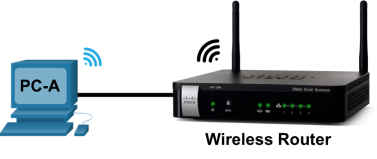13.5.5 Lab – Configure a Wireless Router and Client Answers
Lab – Configure a Wireless Router and Client (Answers Version)
Answers Note: Red font color or gray highlights indicate text that appears in the Answers copy only.
Topology

Sample Wireless Router Settings
|
Network Name (SSID) |
Network Passphrase |
Router Password |
|
Home-Net |
cisco123 |
cisco12345 |
Note: The above wireless router settings are used as example only.
Objectives
Part 1: Configure Basic Settings on a Wireless Router
Part 2: Connect a Wireless Client
Background / Scenario
It is common to access the internet from anywhere in the home or office today. Wireless connectivity is what makes that possible. Users have embraced the flexibility that wireless routers provide for accessing the network and the internet.
In this lab, you will configure a wireless router, which includes applying WPA2 security settings and activating DHCP services. You will also configure a wireless PC client.
Required Resources
- 1 PC with a wireless NIC (Windows 10)
- 1 wireless router
- Ethernet cables as shown in the topology
Instructions
Part 1: Configure Basic Settings on a Wireless Router
One way to configure basic settings on a wireless router is to run the setup CD that came with the router. If you are using the setup CD, you can usually follow the directions provides on the setup CD. If the Setup CD is unavailable, download the setup program from the wireless router manufacturer.
If you choose to manually setup the wireless router, the following direction can be used as a guideline to set up the router.
Step 1: Cable the network as shown in the topology.
- Connect a PC to an unused Ethernet port on the wireless router.
- Connect power cable to the wireless router. Power up the wireless router. Allow time for the router to boot up.
Step 2: Configure the wireless settings.
- From the web browser on the PC, enter the IP address to connect to the wireless router. Most wireless routers use http://192.168.1.1, http://192.168.0.1, or http://192.168.2.1. Enter the default username and password as provided by the manufacturer if necessary to log into the web interface.
- For the Internet setup, use DHCP for the Internet IP address unless the ISP provided you with a static IP address.
- For the local network, enable the DHCP server and use 192.168.100.1/24 as the internal network. The starting IP address is 192.168.100.100, and this network allows a maximum number of DHCP users to 150.
Note: The subnet 192.168.100.0/24 is only used as an example of the lab.
- Renew the IP address on the PC to continue. Enter 192.168.100.1 in the web browser to access the wireless router web interface.
- Configure the SSID as Home-Net.
- Configure the wireless security by setting the authentication type to use the WPA2 Personal and set the passphrase to cisco123.
- Change the administrative password from the default password to cisco12345.
Part 2: Connect a Wireless Client
In Part 2, you will configure the PC’s wireless NIC to connect to the wireless router.
Note: This lab was performed using a PC running Windows 10 operating system. You should be able to perform the lab with other Windows operating systems listed. However, menu selections and screens may vary.
Step 1: Use the Network and Sharing Center.
- Open the Network Connections window by right-clicking Start > select Network Connections.
- The Network Connections window displays the list of NICs available on this PC. Look for your Local Area Connection and Wireless Network Connection adapters in this window.
Note: Other types of network adapters, such as Bluetooth Network connection and Virtual Private Network (VPN) adapter may also be displayed in this window.
Step 2: Work with your wireless NIC.
- Right-click Wireless Network Connection to the available options. The first option displays if your wireless NIC is enabled. Currently, this NIC is enabled because the Disable option is displayed. If your wireless NIC is disabled, you will have an option to Enable it.
- Click Connect/Disconnect to open the NETWORK & INTERNET Settings window.
- Click on Home-Net and select Disconnect.
- A list of SSIDs in range of your wireless NIC is displayed. Re-connect with Home-Net. Select Home-Net, and click Connect.
- If prompted, enter cisco123 to supply the network security key, and then click OK.
Step 3: Verify internet access.
- Verify that the PC received an IP address from the router via DHCP.
- Open a web browser and navigate to a website, such as www.cisco.com.